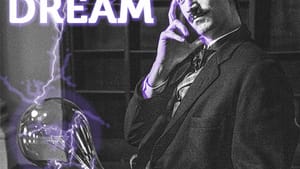Stay in the Loop
BSR publishes on a weekly schedule, with an email newsletter every Wednesday and Thursday morning. There’s no paywall, and subscribing is always free.
An electric mind
Philly Fringe 2019: The Franklin Institute presents Paul Taylor’s ‘Tesla’s Dream’

Nikola Tesla was one of the seminal scientific geniuses of the early 20th century. His technological breakthroughs literally changed the course of modern industrial civilization. But he was also a troubled soul, living with what today might be diagnosed as obsessive-compulsive disorder, which seriously complicated his life and career. Paul Taylor’s Tesla’s Dream brings the man back to life for the Fringe.
The Franklin Institute presents this world premiere, a mixed-media performance that examines both Tesla’s scientific breakthroughs and his troubled mental state.
Fundamental competition
Tesla’s Dream is adapted by director Paul Taylor and co-creator and star David Henry Wrigley mostly from various contemporaneous sources, writings, and speeches by Tesla. Tesla’s early years were a struggle of competing influences between his father, a clergyman, and his mother, an inventor. But the lure of science and invention won him over.
The struggle with competing parental figures would plague Tesla later in his career, as he was caught in a tug-of-war between competing industrialists Thomas Edison and George Westinghouse.
Taylor’s script focuses on Tesla’s dreams about the future of technology, and his intense dreams spurred by his obsession with electricity, its mysteries and potentials. These dreams are rendered by the director in a series of clunky choreographed sequences that were hampered by an ensemble of non-dancers.
Theater or education?
Since this is a Franklin Institute production, the educational aspects of Tesla’s scientific work must be given a high priority. The result is a script that is not as structured or focused as it could be. One sequence that recreates a lecture by Tesla at the Franklin Institute, while educational, brings the story to a grinding halt. It shows the difficulties encountered by a playwright trying to serve more than one creative agenda. Fortunately, sequences like that are often saved from utter dullness by the charm and wit of Wrigley’s portrayal of Tesla.
While the production is uneven, at best, one aspect of it works very well. The story is accompanied/illustrated by a film designed by Matt Lorenz. Lorenz has taken segments of Edison-era silent films and paired them with new sequences designed to mimic the appearance and style of those antique silent films. The result is both impressive and artful.
As an educational project, Tesla’s Dream is credible, but as a theatrical presentation, it needs more work to find focus, and to clarify the story it’s trying to tell.
What, When, Where
Tesla’s Dream. Co-created by Paul Taylor and David Henry Wrigley, directed by Paul Taylor. Through September 15, 2019 at the Franklin Institute, 222 North 20th Street, Philadelphia. (215) 413-1318 or fringearts.com.
The Franklin is a wheelchair-accessible venue.
Sign up for our newsletter
All of the week's new articles, all in one place. Sign up for the free weekly BSR newsletters, and don't miss a conversation.

 Gary L. Day
Gary L. Day